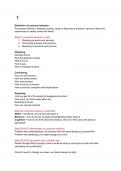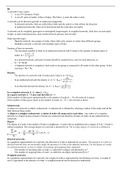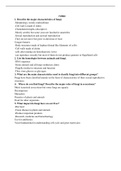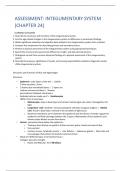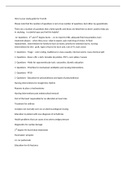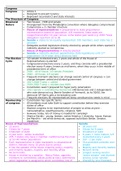1
Definition of consumer behavior
Processes involved in selecting, buying, using or disposing of products, services, ideas and
experiences to satisfy needs and wants.
Slide 21 Consumer behavior model
1. Obtaining products and services
2. Consuming products and services
3. Disposing of products and services
Obtaining
Deciding to buy
Deciding between brands
Where to buy
How to pay
How to transport product
Consuming
How you use product
How you store product
Who uses product
How much you consume
How a products compares with expectations
Disposing
How you get rid of the products (weggooien/recyclen)
How much you throw away after use
Reselling products
How you recycle products
Slide 22 Consumer behavior model ACB
Affect = emotional, how do you feel about it
Behavior = how do we act, buying/reviewing/telling others about it
Cognition = how do we think about the product, what do I think about the product
(good/bad)
Slide 25 till 27 Particularities of consumer behavior
Problem with understanding, not everyone likes the same things you yourself like
Problem with predicting, you might change your mind
Slide 28 till 30 Day center case | Intuition trap
Parents thought that by paying a fine it would be okay to come pick up their kids later
(accepting the punishment).
We don’t want to change our views, we should always be right.
,Slide 31 till 40 Public policy
Market organizations + Governments influence consumer behavior by implementing
rules/laws/marketing activities
Experimental research, influence certain factors to force a certain view.
Slide 45
Self-selection, not representative to the entire population
Self-reports, people might lie
Slide 48 till 50 Wise consumer assumption | Preference reversals
Consumers are irrational
Visual is important
Slide 52 till end | Jam study setup
Compromise effect, intermediate option becomes interesting when the more extreme ones
are too expensive or the quality change is not redeemable.
Endowment effect, owners/sellers value their own products higher than a buyer does.
Choice overload, the brain gets overloaded when it gets too many choices of a product, It’s
starting to get bored.
More choices isn’t always better. Gets too complicated/frustrating, you might overthink what
you’re missing out on. Less choice makes it simpler/easier for the brain.
How do economists think about consumers?
- Rational beings
- Fully aware of all the options
- Always choose the option they like best
Assumptions:
- Full internal knowledge (consumers know their own preferences)
- Full external knowledge (consumers act with full information)
- Maximize utility (consumers choose the best option available)
,2
Slide 4 & 5
! Descriptive research strategy
● Describes individual variables
● Obtains a snapshot (a description) of specific characteristics of a specific group of
individuals
● Data is usually in the form of averages or percentages
Relationship between variables forms:
Linear = A
Curvilinear = D
Positive = B
Negative = C
Slide 6 till 11 Correlation vs causation
! Correlation, measures and describes the relationship between two variables
● The sign (-/+) indicates the direction
● The numerical value (0.0 to 1.0) indicates the strength or consistency of the
relationship
● The type of correlation (Pearson = linear or Spearman = monotonic) indicates the
form of the relationship
Monotonic relationship = In a monotonic relationship, the variables tend to move in the
same relative direction, but not necessarily at a constant rate.
Slide 13 & 14
Degree of relationship
r = 0.1 - 0.3 or r^2 = 0.01 = small correlation
r = 0.3 - 0.5 or r^2 = 0.09 = medium correlation
r = 0.5+ or r^2 = 0.25+ = large correlation
Predictor variable: the first variable
Criterion variable: the second variable (being explained or predicted)
Regression: Statistical process for using one variable to predict the other
Goal: to find the equation that produces the most accurate predictions of Y (the criterion
variable) for each value of X (the predictor variable)
● The predictor variable is relatively simple and well defined
● The criterion variable is relatively complex and unknown
Slide 17 & 18
!Experimental research strategy, answers cause-and-effect questions about the
relationship between two variables. All subjects must have the same factors that count
towards the end result. Need to eliminate all pre-existing variables and the researchers
make the groups/choices.
!Quasi-experimental research strategy, almost, but not quite, experiments - can never
produce an unambiguous explanation. There are still factors (e.g. lifestyle) in play that make
sure test subjects aren’t a good fit for the experiment compared to other test subjects.
, !Nonexperimental research strategy, demonstrates a relationship between variables -
does not attempt to explain it.
Slide 19
Nonexperimental and correlational research
● Same goal, both are designed to demonstrate that a relationship exists between two
variables. Do not try to explain the relationship
● Types of data differ, correlational uses one group of participants (measures two
variables for each person). Nonexperimental compares two groups of scores;
measures only one variable for each individual.
Slide 22 till 24
External validity, the extent to which the results of a research study can be generalized.
Researchers have less/no control over the variables, more like the real world.
A threat to external validity: Any characteristic of a study that limits the ability to generalize
the study’s results. One country is not the other, can’t generalize something when it has only
been tested in one country for example.
Internal validity, concerned with factors in the research study that raise doubts or questions
about the interpretation of the results. Researchers have more control over the variables.
A research study with internal validity produces a single, unambiguous explanation for the
relationship between two variables.
A threat to internal validity: Any factor that allows an alternative explanation for the results.
Threats to internal and external
Artifact: an external factor that may influence or distort measurements.
- Experimenter bias
- Demand characteristics
Exaggerated variables:
- Researchers should be cautious about generalizing the result of a study with
exaggerated variables.
Slide 26 Confounding variable
Slide 28
Goal of any research study: Maximize internal and external validity
Researchers decide which validity is more important to their study.
Definition of consumer behavior
Processes involved in selecting, buying, using or disposing of products, services, ideas and
experiences to satisfy needs and wants.
Slide 21 Consumer behavior model
1. Obtaining products and services
2. Consuming products and services
3. Disposing of products and services
Obtaining
Deciding to buy
Deciding between brands
Where to buy
How to pay
How to transport product
Consuming
How you use product
How you store product
Who uses product
How much you consume
How a products compares with expectations
Disposing
How you get rid of the products (weggooien/recyclen)
How much you throw away after use
Reselling products
How you recycle products
Slide 22 Consumer behavior model ACB
Affect = emotional, how do you feel about it
Behavior = how do we act, buying/reviewing/telling others about it
Cognition = how do we think about the product, what do I think about the product
(good/bad)
Slide 25 till 27 Particularities of consumer behavior
Problem with understanding, not everyone likes the same things you yourself like
Problem with predicting, you might change your mind
Slide 28 till 30 Day center case | Intuition trap
Parents thought that by paying a fine it would be okay to come pick up their kids later
(accepting the punishment).
We don’t want to change our views, we should always be right.
,Slide 31 till 40 Public policy
Market organizations + Governments influence consumer behavior by implementing
rules/laws/marketing activities
Experimental research, influence certain factors to force a certain view.
Slide 45
Self-selection, not representative to the entire population
Self-reports, people might lie
Slide 48 till 50 Wise consumer assumption | Preference reversals
Consumers are irrational
Visual is important
Slide 52 till end | Jam study setup
Compromise effect, intermediate option becomes interesting when the more extreme ones
are too expensive or the quality change is not redeemable.
Endowment effect, owners/sellers value their own products higher than a buyer does.
Choice overload, the brain gets overloaded when it gets too many choices of a product, It’s
starting to get bored.
More choices isn’t always better. Gets too complicated/frustrating, you might overthink what
you’re missing out on. Less choice makes it simpler/easier for the brain.
How do economists think about consumers?
- Rational beings
- Fully aware of all the options
- Always choose the option they like best
Assumptions:
- Full internal knowledge (consumers know their own preferences)
- Full external knowledge (consumers act with full information)
- Maximize utility (consumers choose the best option available)
,2
Slide 4 & 5
! Descriptive research strategy
● Describes individual variables
● Obtains a snapshot (a description) of specific characteristics of a specific group of
individuals
● Data is usually in the form of averages or percentages
Relationship between variables forms:
Linear = A
Curvilinear = D
Positive = B
Negative = C
Slide 6 till 11 Correlation vs causation
! Correlation, measures and describes the relationship between two variables
● The sign (-/+) indicates the direction
● The numerical value (0.0 to 1.0) indicates the strength or consistency of the
relationship
● The type of correlation (Pearson = linear or Spearman = monotonic) indicates the
form of the relationship
Monotonic relationship = In a monotonic relationship, the variables tend to move in the
same relative direction, but not necessarily at a constant rate.
Slide 13 & 14
Degree of relationship
r = 0.1 - 0.3 or r^2 = 0.01 = small correlation
r = 0.3 - 0.5 or r^2 = 0.09 = medium correlation
r = 0.5+ or r^2 = 0.25+ = large correlation
Predictor variable: the first variable
Criterion variable: the second variable (being explained or predicted)
Regression: Statistical process for using one variable to predict the other
Goal: to find the equation that produces the most accurate predictions of Y (the criterion
variable) for each value of X (the predictor variable)
● The predictor variable is relatively simple and well defined
● The criterion variable is relatively complex and unknown
Slide 17 & 18
!Experimental research strategy, answers cause-and-effect questions about the
relationship between two variables. All subjects must have the same factors that count
towards the end result. Need to eliminate all pre-existing variables and the researchers
make the groups/choices.
!Quasi-experimental research strategy, almost, but not quite, experiments - can never
produce an unambiguous explanation. There are still factors (e.g. lifestyle) in play that make
sure test subjects aren’t a good fit for the experiment compared to other test subjects.
, !Nonexperimental research strategy, demonstrates a relationship between variables -
does not attempt to explain it.
Slide 19
Nonexperimental and correlational research
● Same goal, both are designed to demonstrate that a relationship exists between two
variables. Do not try to explain the relationship
● Types of data differ, correlational uses one group of participants (measures two
variables for each person). Nonexperimental compares two groups of scores;
measures only one variable for each individual.
Slide 22 till 24
External validity, the extent to which the results of a research study can be generalized.
Researchers have less/no control over the variables, more like the real world.
A threat to external validity: Any characteristic of a study that limits the ability to generalize
the study’s results. One country is not the other, can’t generalize something when it has only
been tested in one country for example.
Internal validity, concerned with factors in the research study that raise doubts or questions
about the interpretation of the results. Researchers have more control over the variables.
A research study with internal validity produces a single, unambiguous explanation for the
relationship between two variables.
A threat to internal validity: Any factor that allows an alternative explanation for the results.
Threats to internal and external
Artifact: an external factor that may influence or distort measurements.
- Experimenter bias
- Demand characteristics
Exaggerated variables:
- Researchers should be cautious about generalizing the result of a study with
exaggerated variables.
Slide 26 Confounding variable
Slide 28
Goal of any research study: Maximize internal and external validity
Researchers decide which validity is more important to their study.

